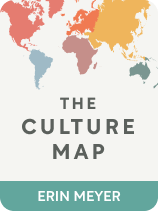

This article is an excerpt from the Shortform book guide to "The Culture Map" by Erin Meyer. Shortform has the world's best summaries and analyses of books you should be reading.
Like this article? Sign up for a free trial here .
Is Erin Meyer’s The Culture Map worth reading? What is Meyer’s framework for measuring behavioral differences across cultures?
In The Culture Map, Erin Meyer presents eight axes you can use as a framework to analyze cultural differences: communication, feedback, thinking, leadership, decision-making, trust, disagreement, and time perception. Meyer positions countries on each axis, each of which represents a range of possible behavior between two extremes.
The following The Culture Map review covers the book’s context, background, and critical reception.
About the Author
Erin Meyer is a professor at INSEAD, one of the world’s top international business schools. The Culture Map was her first book. She is also the co-author of the 2020 New York Times bestseller No Rules Rules: Netflix and the Culture of Reinvention.
Connect with Erin Meyer:
The Book’s Publication
Publisher: PublicAffairs
The Culture Map was published in 2014 by PublicAffairs and became a bestseller. It also established Meyer’s international reputation as a cultural expert: Her 2015 Harvard Business Review article on international negotiation, “Getting to Si, Ja, Oui, Hai, and Da,” was the publication’s most-read article of the year.
The Book’s Intellectual Context
Meyer isn’t the first to attempt to use a multidimensional framework to explain cultural differences. Beginning in 1959, American anthropologist Edward T. Hall published several books examining how various cultures viewed specific concepts differently. In 1980, Dutch management researcher Geert Hofstede examined this in a visual manner with Hofstede’s cultural dimensions theory. Finally, the Netherlands’s Alfonsus Trompenaars and Britain’s Charles Hampdens-Turner popularized a framework of how these cultural frameworks affect business and management with their 1997 publication of Riding the Waves of Culture.
Meyer builds on and adapts all of these frameworks in her book. Her work is also sometimes compared to Richard Lewis’s When Cultures Collide, a 2005 tome by a British cross-cultural expert. Meyer doesn’t provide in-depth analysis of individual countries the way Lewis does. Rather, she provides a framework that readers can use to assess any culture even if she doesn’t cover it. Her visuals also help readers assess the magnitude of cultural differences.
Critical Reception
Online, The Culture Map reviews agree that it is an easily digestible and actionable read. They were able to apply actionable strategies to both their personal and professional lives, and they enjoyed the visual format Meyer uses to present her ideas.
Online reviewers who find fault with the book think that Meyer relies too heavily on personal anecdotes from her time at INSEAD and fails to provide concrete evidence for her argument. Some think that identifying cultural norms without sufficient evidence perpetuates harmful cultural stereotypes. Reviewers also mention that Meyer focuses too heavily on some regions and neglects others, specifically Central and South America and Africa.
Commentary on the Book’s Approach
Meyer’s book repackages many of the ideas presented by Hall, Hofstede, Trompenaars, and Hampdens-Turner. Sometimes, she cites their work in the book, and she thanks them in her Acknowledgments at the end of the text. However, she often makes claims based on their ideas without citing their work. This may explain why many reviewers thought that Meyer didn’t provide sufficient evidence for her claims.
As noted, throughout the book, Meyer relies heavily on anecdotes from her seminars and lectures, and she doesn’t always provide rigorous research to back up her claims. The narrative elements make her work easily digestible, but her lack of research is problematic: Not only has Meyer failed to publish any peer-reviewed research on her claims, she also admits to changing identifying details of the people involved in her anecdotes in order to protect them. Consequently, Meyer asks for a huge amount of trust from her reader—and not everybody gives it to her.
Finally, it’s true that Meyer mostly focuses on Europe, Asia, and the Anglo-Saxon countries. But as this is a business book published by an American company, it makes sense that Meyer focuses most on the cultures that Americans are most likely to encounter in the business landscape. And it’s not that she ignores other regions completely—her chapter on scheduling, for example, focuses extensively on Nigeria.
Commentary on the Book’s Organization
Meyer starts the book with an introduction that explains how she developed this framework, why it’s necessary, and how to interpret it. She then devotes one chapter to each of eight axes of cultural difference, explaining what the axes are, how they developed, and how to work with people from axes that are opposite to yours. Each chapter also includes several anecdotes that demonstrate real-life applications of Meyer’s teachings. Finally, in her epilogue, she synthesizes her teachings visually and presents several general strategies her reader can use when working across cultures.

———End of Preview———
Like what you just read? Read the rest of the world's best book summary and analysis of Erin Meyer's "The Culture Map" at Shortform .
Here's what you'll find in our full The Culture Map summary :
- The eight axes you can use as a framework to analyze cultural differences
- How to better relate to those of another culture to accomplish business goals
- How the Vikings have more gender equality than we see today






